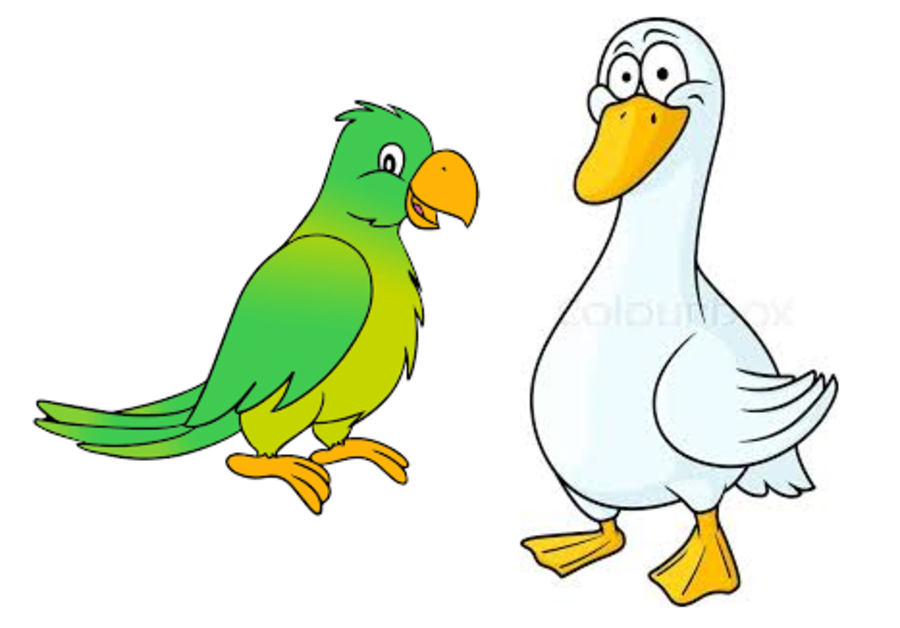Parrot or goose?
John plays a game with Bobart where each person takes turns saying either parrot or goose. At the beginning of the game John picks randomly between four possible strategies:

- Tit for Tat: Repeat whatever the other player says.
- Goose: Always say goose.
- Parrot: Always say parrot.
- Random: Pick randomly every time.
The game proceeds as follows:
| Bobart | John |
| Goose | Goose |
| Goose | Goose |
| Goose | Goose |
What is the probability that John picked "Tit for Tat"? If the probability is b a , where a and b are coprime positive integers, give a + b as your answer.
Image credit : https://www.colourbox.com http://www.clipartlord.com
The answer is 25.
This section requires Javascript.
You are seeing this because something didn't load right. We suggest you, (a) try
refreshing the page, (b) enabling javascript if it is disabled on your browser and,
finally, (c)
loading the
non-javascript version of this page
. We're sorry about the hassle.
3 solutions
First, it should be stated that it is only John that is choosing and adhering to these strategies. We don't need to include any probabilities for Bobart choosing a strategy - Bobart saying "Goose", "Goose", "Goose" is a given.
Even though some of the outcomes aren't possible for the 4 strategies, they still factor as outcomes. With 2 mutually exclusive outcomes for each of the 3 turns, each strategy has 2 3 outcomes to consider - It's just that 100 percent (ie 1 = 8 8 ), or 0 percent (ie 0 = 8 0 ) of the probability is weighted towards particular outcomes for some strategies.
The total number of valid & invalid outcomes for the 4 strategy choices, and potential "Parrot" & "Goose" permutations after 3 turns:
4 ⋅ 2 3 = 3 2
Invalid outcomes being those that are rendered impossible by the strategy - Eg: Saying "Goose" when using the Parrot strategy.
Valid outcomes being those that are probable.
Had John chosen Parrot as a strategy in isolation ( p i ), rather than within the context of the total valid & invalid outcomes for all 4 strategies ( P ), the probability of John saying "Goose", "Goose", "Goose" given Bobart says "Goose", "Goose", "Goose" is: p i = 0 = 8 0 → P = 3 2 0
Had John chosen Goose as his strategy in isolation ( g i ), rather than within the context of the total valid & invalid outcomes for all 4 strategies ( G ), the probability of John saying "Goose", "Goose", "Goose" given Bobart says "Goose", "Goose", "Goose" is: g i = 1 = 8 8 → G = 3 2 8
Had John chosen Tit for Tat as his strategy in isolation ( t i ), rather than within the context of the total valid & invalid outcomes for all 4 strategies ( T ) , the probability of John saying "Goose", "Goose", "Goose" given Bobart says "Goose", "Goose", "Goose" is. t i = 1 = 8 8 → T = 3 2 8
Had John chosen Random as his strategy in isolation ( r i ), rather than within the context of the total valid & invalid outcomes for all 4 strategies ( R ), the probability of John saying "Goose", "Goose", "Goose" given Bobart says "Goose", "Goose", "Goose" is: r i = 2 3 1 = 8 1 → R = 3 2 1
When considering all 4 strategies, the number of valid outcomes for John saying "Goose", "Goose", "Goose" given Bobart says "Goose", "Goose", "Goose" is: P + G + T + R = 3 2 0 + 3 2 8 + 3 2 8 + 3 2 1 = 3 2 1 7
Given the valid outcomes for John saying "Goose", "Goose", "Goose" when Bobart said "Goose", "Goose", "Goose" , the probability that Tit for Tat was John's chosen strategy out of the 4 available is: 0 + 8 + 8 + 1 8 = 1 7 8
8 + 1 7 = 2 5
I've probably just upset a number of mathematicians that properly understand probability with my ham-fisted approach.
Clearly john did not pick parrot, because the given outcome cannot occur.
If john picked tit for tat, the given outcome is guaranteed
If john picked goose, the given outcome is guaranteed
If john picked random, the given outcome occurs with probability 1÷8
The total of correct outcome is distributed as 0:8:8:1 over the strategies, and 'tit for tat' accounts for 8÷17 of this.
Using Baye's Theorem , we have that
P ( T T ∣ G G G ) = P ( G G G ) P ( G G G ∣ T T ) P ( T T )
where:
P ( T T ∣ G G G ) = P ( G G G ) 1 ⋅ 4 1
= P ( T T ) P ( G G G ∣ T T ) + P ( G s ) P ( G G G ∣ G s ) + P ( P a r ) P ( G G G ∣ P a r ) + P ( R n ) P ( G G G ∣ R n ) 4 1
where
P ( T T ∣ G G G ) = 4 1 + 4 1 + 0 + 4 1 ⋅ 8 1 4 1
= 3 2 1 7 4 1
= 1 7 8
8 + 1 7 = 2 5